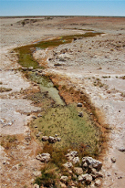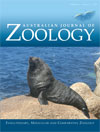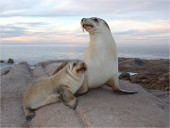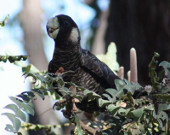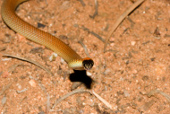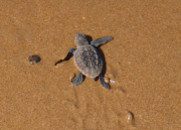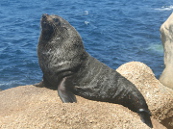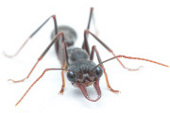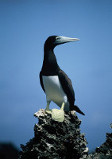Australian Journal of Zoology
Volume 61
Number 2 2013
16 microsatellite loci were successfully amplified for 30 individuals of the Great Artesian Basin (GAB) amphipod, Wangiannachiltonia guzikae, from a single GAB spring population. Observed heterozygosity ranged from 0.000 to 0.818 (mean = 0.445) and the number of alleles per locus ranged from 2 to 12 (mean = 6.688).
Photo by Nick Murphy.
The Australian sea lion is an endemic, endangered species. We assessed trends in pup numbers at The Pages Islands (South Australia) over 14 breeding seasons (1989–90 to 2009–10). The average number was 473 and there was no trend in abundance, contrasting with two other colonies: Seal Bay (decreasing) and Dangerous Reef (increasing).
Photo by Simon Goldsworthy (SARDI Aquatic Sciences).
Observations of feeding birds and feeding residues under trees confirmed that rehabilitated mine pits in south-western Australia provide food for threatened black cockatoos within a decade. Food availability in revegetated pits reflects vegetation succession after establishment, with proteaceous shrubs important early, followed by eucalypt trees. Revegetation benefits black cockatoos quickly.
Photo by Jessica Lee.
We encountered 69 orange-naped snakes (Furina ornate) along a 77-km road over 12 months. Females were larger than males, and both sexes were larger than previously reported. Activity was not related to temperature, rainfall or humidity and snakes were more likely to be recorded in areas with increased hummock grass cover.
Photo by Peter McDonald.
Sea-finding behaviour was investigated in loggerhead turtles emerging from nests along the Woongarra coast, Australia. On naturally dark beaches, hatchlings emerged from nests and headed straight for the sea in all moon phases. On light-polluted beaches, hatchlings were attracted inland, but this behaviour was mitigated by moon light.
Photo by Tyffen Read.
This review aims to identify climate change impacts on Australian marine mammals. Potential effects include changes in distribution and reproductive success, loss of habitat, increases in stranding events, and greater exposure to pollutants and pathogens. To increase the resilience of Australian marine mammals, non-climatic threats must be addressed.
Photo by Nicole Schumann.
We used radio-tracking to investigate the movement of Murray cod (Maccullochella peelii) during a flood and associated blackwater event in the lower River Murray. Murray cod displayed individual variation in movement and dispersal, including large-scale riverine movements, but were consistently located in main channel or permanent anabranch habitats. Mortality was considerable (25%) in association with hypoxic blackwater.
Photo by Brenton Zampatti.
We report on the foraging behaviour of the night-active bull ant Myrmecia pyriformis. Most foragers make only one foraging journey per night, leaving the nest at dusk and returning during dawn. Night-time activity varies with moon illumination, and is likely due to changes in light levels which influence navigation.
Photo by Ajay Narendra.
Leucocyte profiles in inshore foraging, sexually dimorphic brown boobies suggested higher stress levels in males than females, particularly during chick rearing compared to incubation. No differences were found in offshore foraging, monomorphic red-tailed tropicbirds. The results imply the importance of sex- and species-specific foraging behaviour for the birds’ immunology.
Photo by Janos C. Hennicke.
